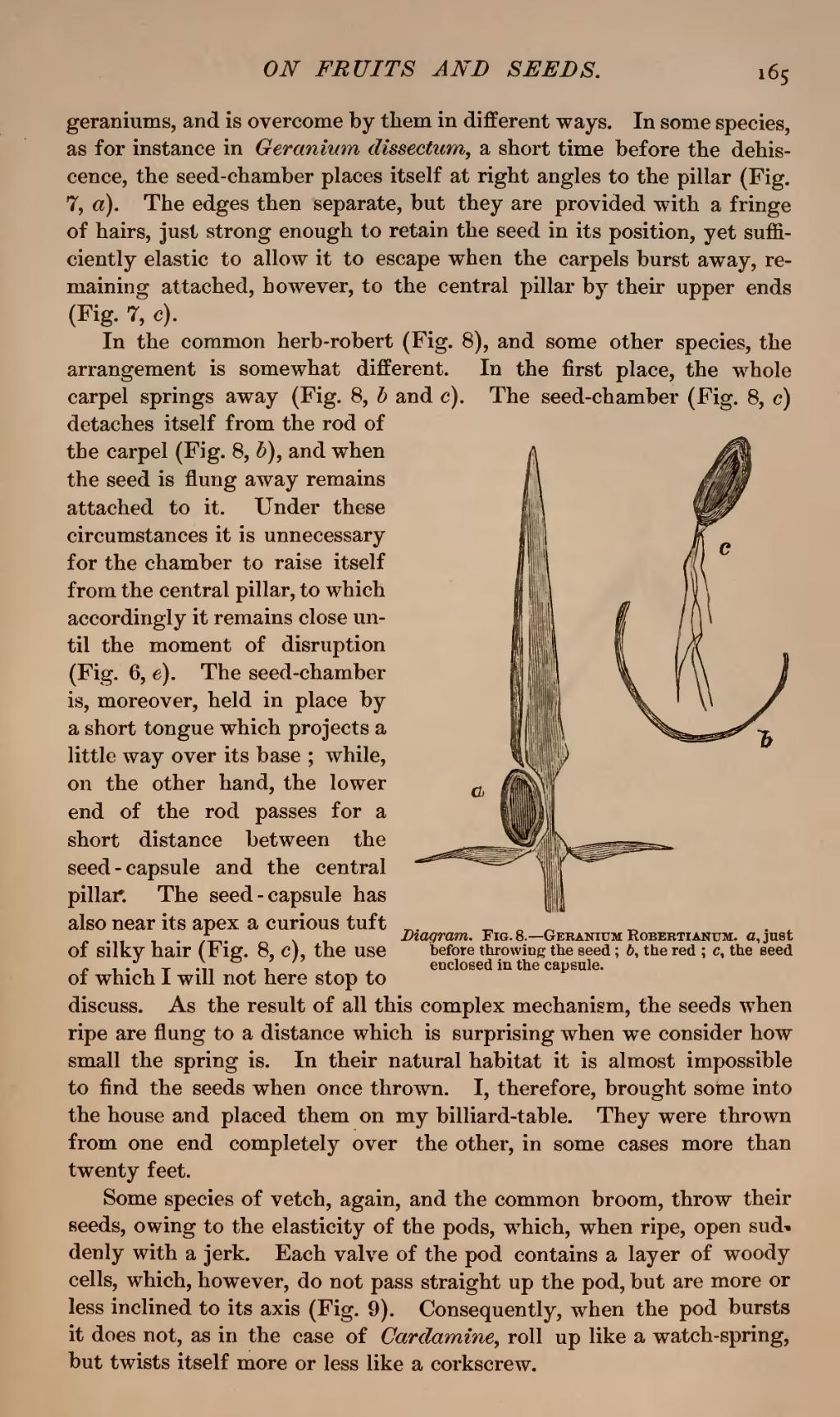geraniums, and is overcome by them in different ways. In some species, as for instance in Geranium dissectum, a short time before the dehiscence, the seed-chamber places itself at right angles to the pillar (Fig. 7, a). The edges then separate, but they are provided with a fringe of hairs, just strong enough to retain the seed in its position, yet sufficiently elastic to allow it to escape when the carpels burst away, remaining attached, however, to the central pillar by their upper ends (Fig. 7, c).
In the common herb-robert (Fig. 8), and some other species, the arrangement is somewhat different. In the first place, the whole carpel springs away (Fig. 8, b and c). The seed-chamber (Fig. 8, c)
 Diagram.Fig. 8.—Geranium Robertianum. a, just before throwing the seed; b, the red; c, the seed enclosed in the capsule. detaches itself from the rod of the carpel (Fig. 8, b), and when the seed is flung away remains attached to it. Under these circumstances it is unnecessary for the chamber to raise itself from the central pillar, to which accordingly it remains close until the moment of disruption (Fig. 6, e). The seed-chamber is, moreover, held in place by a short tongue which projects a little way over its base; while, on the other hand, the lower end of the rod passes for a short distance between the seed-capsule and the central pillar. The seed-capsule has also near its apex a curious tuft of silky hair (Fig. 8, c), the use of which I will not here stop to discuss. As the result of all this complex mechanism, the seeds when ripe are flung to a distance which is surprising when we consider how small the spring is. In their natural habitat it is almost impossible to find the seeds when once thrown. I, therefore, brought some into the house and placed them on my billiard-table. They were thrown from one end completely over the other, in some cases more than twenty feet.
Diagram.Fig. 8.—Geranium Robertianum. a, just before throwing the seed; b, the red; c, the seed enclosed in the capsule. detaches itself from the rod of the carpel (Fig. 8, b), and when the seed is flung away remains attached to it. Under these circumstances it is unnecessary for the chamber to raise itself from the central pillar, to which accordingly it remains close until the moment of disruption (Fig. 6, e). The seed-chamber is, moreover, held in place by a short tongue which projects a little way over its base; while, on the other hand, the lower end of the rod passes for a short distance between the seed-capsule and the central pillar. The seed-capsule has also near its apex a curious tuft of silky hair (Fig. 8, c), the use of which I will not here stop to discuss. As the result of all this complex mechanism, the seeds when ripe are flung to a distance which is surprising when we consider how small the spring is. In their natural habitat it is almost impossible to find the seeds when once thrown. I, therefore, brought some into the house and placed them on my billiard-table. They were thrown from one end completely over the other, in some cases more than twenty feet.
Some species of vetch, again, and the common broom, throw their seeds, owing to the elasticity of the pods, which, when ripe, open suddenly with a jerk. Each valve of the pod contains a layer of woody cells, which, however, do not pass straight up the pod, but are more or less inclined to its axis (Fig. 9). Consequently, when the pod bursts it does not, as in the case of Cardamine, roll up like a watch-spring, but twists itself more or less like a corkscrew.
